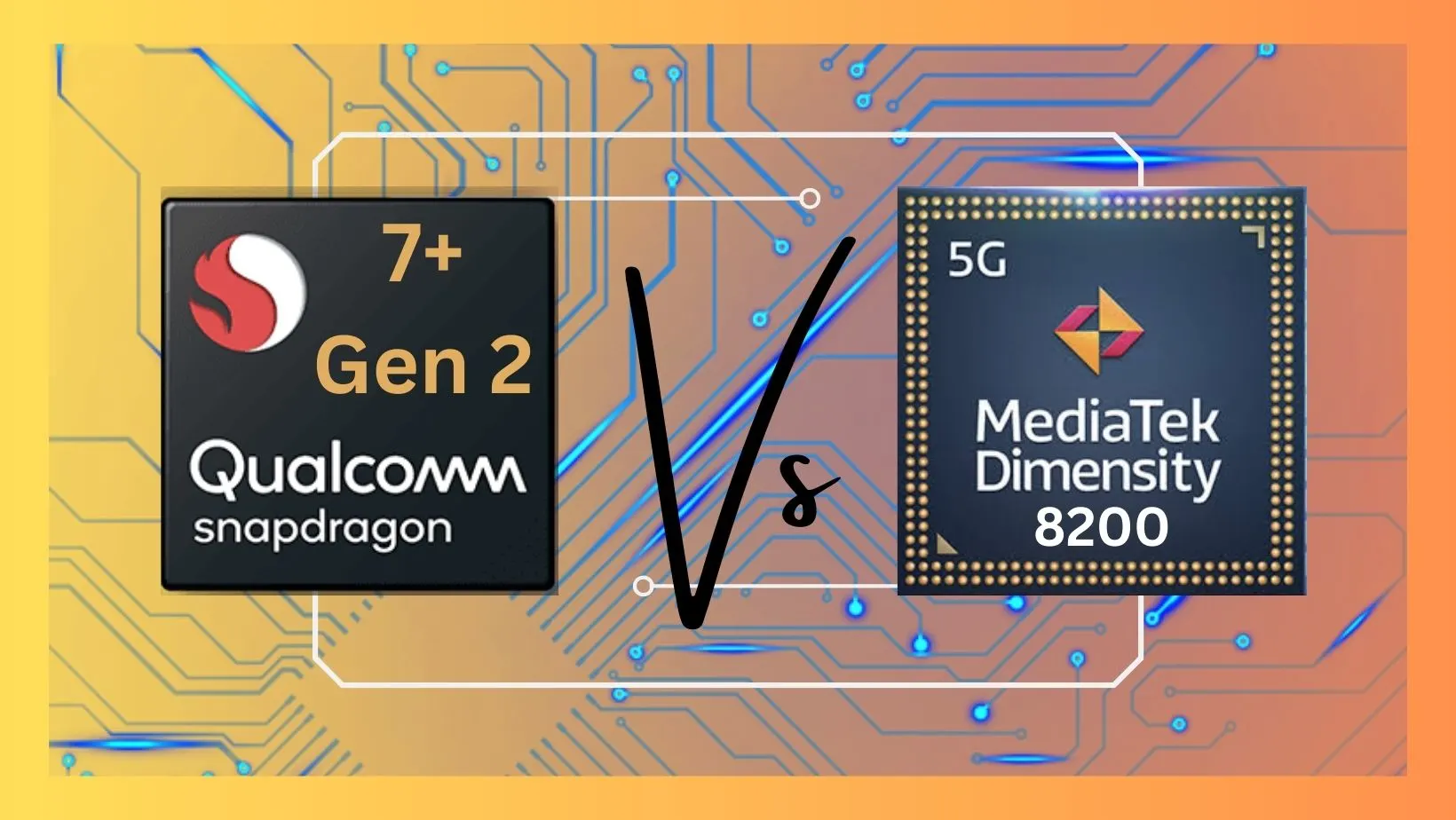Snapdragon 7+ Gen 2 Vs. Dimensity 8200
The Snapdragon 7+ Gen 2 and the MediaTek Dimensity 8200 are two high-end midrange SoCs that offer something akin to flagship performance. However, which one is the better option? Read on to find out
Qualcomm and MediaTek, longstanding competitors in the mobile industry, often see their SoCs pitted against each other. In this article, we are going to be comparing two of their SoCs: the Snapdragon 7+ Gen 2 Vs. MediaTek Dimensity 8200.
The Snapdragon 7+ Gen 2 is an upper midrange SoC from Qualcomm. It was introduced in March 2022 and it is the successor to the Snapdragon 7 Gen 1. Renowned for its flagship-grade performance, it is featured in smartphones such as the Poco F5, Redmi Note 12 Turbo, and the Realme GT Neo 5 SE.
Conversely, the Dimensity 8200 is also a midrange SoC, albeit from MediaTek. It replaced the Dimensity 8100 and it is older than the Snapdragon 7+ Gen 2. This is because it was announced in December of 2022. Despite being older, the Dimensity 8200 isn't widely embraced by smartphone manufacturers, but you can find it on devices like the Xiaomi 13T, Xiaomi 12T Pro, Vivo S17 Pro, and the Unihertz Tank 3.
With this context, let's engage which SoC is the better one in this Snapdragon 7+ Gen 2 vs Dimensity 8200 debate.
>> See: Snapdragon 7+ Gen 2 Vs. Dimensity 8200 - Full Specs Comparison
Performance of the Snapdragon 7+ Gen 2 vs Dimensity 8200
In terms of performance, both SoCs employ a 1+3+4 DynamIQ setup but differ in their CPU configurations. The Snapdragon 7+ Gen 2 boasts a superior Cortex X2 + Cortex A710 + Cortex A510 combination. This combination outclasses the Cortex A78 + Cortex A78 + Cortex A55 setup on the Dimensity 8200. As a result, the Snapdragon 7+ Gen 2 is expected to outperform the Dimensity 8200 in tasks demanding substantial CPU power. These include intensive applications and games.
Benchmark results from AnTuTu and GeekBench reinforce this superiority. The Snapdragon 7+ Gen 2 surpasses the Dimensity 8200 by over 200,000 points on AnTuTu 10 (1,113,000 to 890,000) and exhibits a 13% advantage on GeekBench 6 (3910 to 4428).
Gaming of the Dimensity 7030 vs Snapdragon 7s Gen 2
In the graphics and gaming department, the Snapdragon 7+ Gen 2 holds a notable advantage with its Adreno 725 GPU. This GPU is better than the Mali G610 MP6 on the Dimensity 8200. This is substantiated by concrete evidence rather than mere speculation. According to benchmarks like 3DMark Wildlife and Compute GPU, the Adreno 725 performs better (at least by 20%) than the Mali G610 MP6.
Beyond benchmark results, an additional advantage lies in the development landscape. Developers often prioritize optimizing their games, applications, and software for better performance on Adreno GPUs. This offers them a potential edge that might not be evident solely from benchmarks and specifications. It is worth noting that MediaTek typically only focuses such optimizations on their flagship processors. This potentially puts the Adreno 725 in an even more favorable position.
You may also be interested in:
- MediaTek Unveils Dimensity 8300 Chipset with Cutting-Edge Armv9 CPU, Enhanced GPU, and Generative AI
- TSMC Gains Edge in Chip Race as Qualcomm and MediaTek Abandon Samsung's 3nm
- Redmi K70 Series Launches with Upgraded Camera and Snapdragon 8 Gen 3 Processor
RAM and Storage
In terms of RAM and storage, both SoCs present an identical configuration. They feature the same LPDDR5 RAM with a maximum speed of 3200MHz, supporting up to 16GB of RAM. Moreover, both the Dimensity 8200 and Snapdragon 7+ Gen 2 offer support for UFS 3.1 on the storage front, resulting in a tie between the two in this category.
Camera and Video
For camera support, the Dimensity 8200 outshines its competition by supporting sensors with resolutions of up to 320MP. In contrast, the Snapdragon 7+ Gen 2 is limited to cameras with a maximum resolution of 200MP. This advantage is needless as the highest camera resolutions available are pegged at 200MP. For video functionality, both SoCs are on par, being able to record and playback 4K video at 60fps.
The Snapdragon 7+ Gen is armed with a Spectra ISP which is supported by a Hexagon DSP NPU for processing the outputs captured by the cameras. The Dimensity 8200 is equipped with a MediaTek Imagiq 785 which is supported by an APU 580 AI processor.
Connectivity
In terms of connectivity, these SoCs share similar specifications, encompassing Bluetooth 5.2, WiFi 6, GPS, 4G LTE, and 5G. Notably, the Dimensity 8200 stands out with faster download speeds on both 4G and 5G networks.
Battery life
Both SoCs are made using a highly efficient 4nm TSMC process. Although software optimization plays a significant role, the battery life and energy efficiency of both SoCs are expected to be comparable.
Conclusion
Both SoCs are on par in most areas such as RAM, storage, connectivity, battery life, and camera support. However, the faster performance and superior gaming ability of the Snapdragon 7+ Gen 2 is too tempting to pass up. The Dimensity 8200 has a slightly faster download speed on 5G but I suspect that it may not be enough to convince many consumers. Its only saving grace is that it's very affordable for the level of performance that it offers.
In the end, there is only one winner here and it is the Snapdragon 7+ Gen 2.
